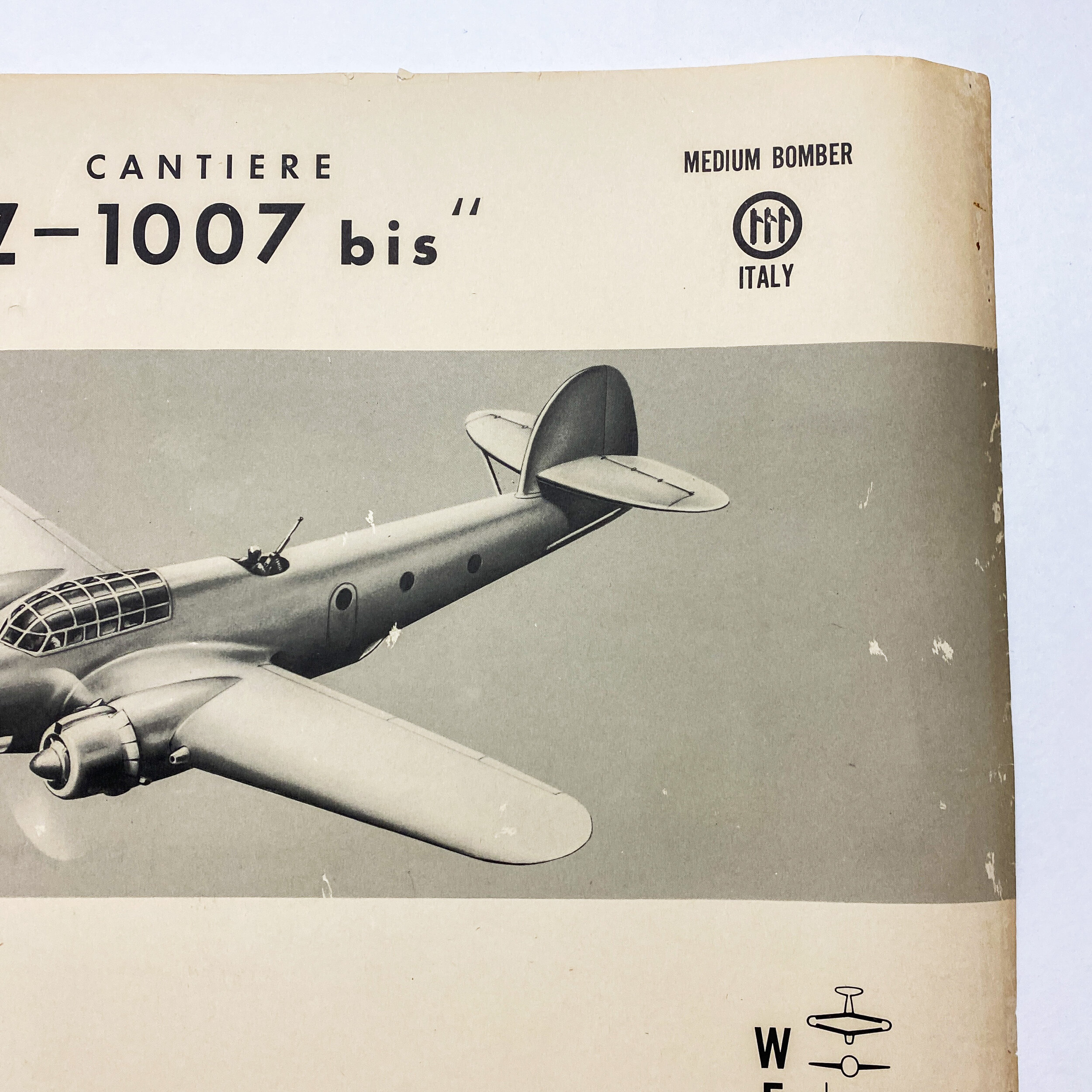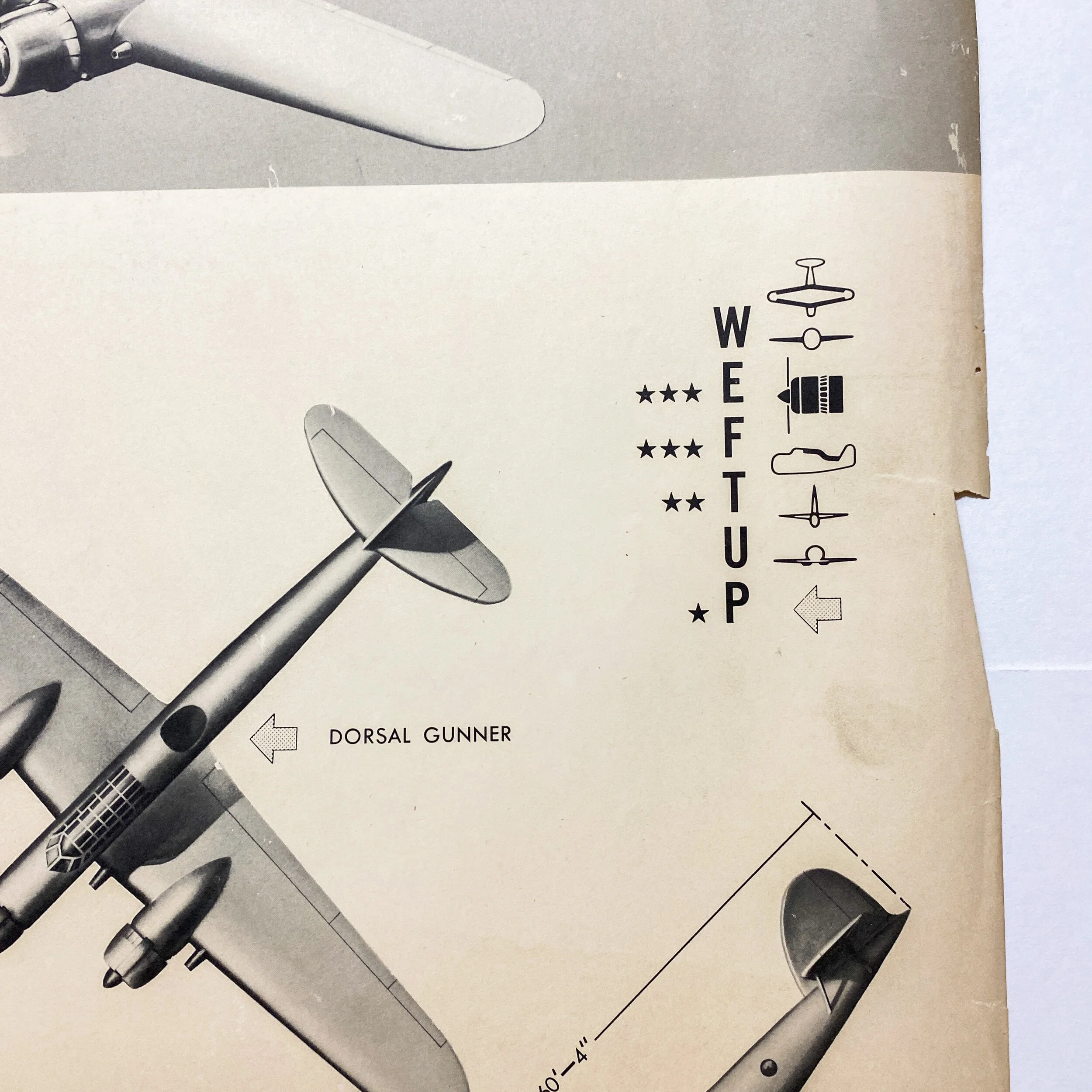Italy Bomber Cantiere Z-1007 bis Aviation Training W.E.F.T.U.P. ID Posters








Italy Bomber Cantiere Z-1007 bis Aviation Training W.E.F.T.U.P. ID Posters
Size: 19 x 25 inches
This original ‘RESTRICTED’ aircraft identification poster was published by the U.S. Naval Aviation Training Division March 1943. This poster was posted as a training tool as well as an in theater ID poster to help U.S. and other Allied pilots, bomber crews and Naval personal to identify Allied and enemy aircraft. W.E.F.T.U.P. or Wing, Engine, Fuselage, Tail, Undercarriage, Peculiarities was a system set up for the purpose of aircraft identification and recognition.
World War II saw some of the first introduction of these aircraft ID poster to prevent friendly fire and more accurate plane recognition in combat. It was believed these posters alone could save countless lives from friendly aircraft-on-aircraft or friendly anit-aircraft fire. These posters also could cut down precious second pilots, bomber gunners, and naval gun crews would have to ID a plane flying towards them intern saving their lives by shooting first.
Each poster provides the silhouettes, dimensions, and relevant information to educate both air and ground personnel in aircraft identification. Immediate identification of aircraft, friendly or not, was essential in order for the observer (whether in the air e.g., pilot, gunner, or patrol observer, or on the ground, e.g., anti-aircraft crew) to determine his next course of action (e.g., acknowledge, attack, evade, or report). Each poster details a large clean sky and background image of the specified aircraft located as the main top imagine on the poster. It also contains important ‘peculiarities’ such as where certain gun emplacements are located, other special aircraft features, as well as wing and length measurements.
Italy Bomber Cantiere Z-1007 bis:
The CANT Z.1007 Alcione (Kingfisher) was an Italian three-engined medium bomber, with wooden structure. Designed by Filippo Zappata, who also designed the CANT Z.506 it had "excellent flying characteristics and good stability" and was regarded by some as "the best Italian bomber of World War II" although its wooden structure was easily damaged by the climate, as experienced in North Africa and in Russia. It was used by the Italian Regia Aeronautica, Italian Co-Belligerent Air Force, Aeronautica Nazionale Repubblicana and Luftwaffe during World War II.
The first Asso-powered Z.1007s were used to equip the 50° Gruppo of the 16° Stormo from May 1939. The Asso powered bombers were not considered suitable for operational use, however, owing to the unreliability of their engines and high maintenance requirements, while their defensive armament was considered inadequate. They were therefore used as trainers. In 1942, it was proposed to modify the remaining 16 Z.1007s for weather reconnaissance, re-engining them with Isotta Fraschini Delta engines, but only one aircraft was converted.The Z.1007 participated in the bombing campaign over Malta and in the campaigns in North Africa and on the Eastern Front. Although fast, these bombers were vulnerable when hit and prone to catch fire.
The 47° Stormo was equipped with some of the first production aircraft at Ghedi. Only four were in service at 10 June 1940. The production was slow with fifteen machines made every month at best. With time the aircraft was used by different Stormi like the 9° and substituted the SM.79 and BR.20.
CANT Z.1007 Asso replaced SM.81s in 16° Stormo, 47° Stormo had Z.1007Bis but operational readiness was only reached in August, when around thirty machines were sent to Sicily to attack Malta. Stormi 16°, 12°, 35°, and 47° operated over Greece with some losses. 175a Squadriglia da ricognizione (reconnaissance squadron), and later 176a, were used in Africa. The British destroyer HMS Juno was sunk by an explosion caused by a Z.1007 bombing in 1941. 35° Stormo was sent to Africa in the bombing role. These three-engine aeroplanes were used occasionally in Russia too. In 1942, Z.1007s were used by four groups and two wings in the Mediterranean theatre, in anti-ship role and against Malta, often escorted by Italian and German fighters.
In November 1942, there were 10 Gruppi equipped with 75 Z.1007s, with just 39 serviceable aircraft.
As part of Italian and German efforts to stop the British Operation Pedestal convoy to re-supply Malta in August 1942, a few Z.1007 Alciones of 51° Gruppo Autonomo based in Alghero, Sardinia, flew reconnaissance missions on the convoy between bombing and raids. Only on 14 August, at the end of that "Mid-August Battle", did three Z.1007bis bomb the convoy from high altitude. Another Z.1007bis took part in the battle, carrying out a first in the war special mission, later copied by Allied air forces.[citation needed] The plan of Generale Ferdinando Raffaelli to use a CANT Z.1007 to radio-guide a "SIAI Marchetti SM.79 ARP (Aereo Radio Pilotato, "Aircraft Radio Guided") bomber. The SM.79, without crew and armament, but packed with explosives and equipped with a radio control device, was to be used as a "Flying Bomb" against big naval targets. As the Pedestal Convoy was off the Algerian coast on 12 August 1942, the SM.79 "Drone", the Z.1007bis guide aircraft and escort of five FIAT G.50 fighters flew out to intercept the ships. Once the SM.79's pilot had set his aircraft on a course toward the Allied ships, he bailed out leaving the Z.1007bis crew to guide the flying bomb the rest of the way by radio. The radio, however, malfunctioned. With nothing to guide it, the SM.79-Drone cruised along until it ran out of fuel and crashed on Mount Klenchela, on the Algerian mainland. The few Z.1007ter still flying after the Allied invasion of Sicily went on to fight with the Italian Social Republic, Italian Co-Belligerent Air Force and the 'Luftwaffe.